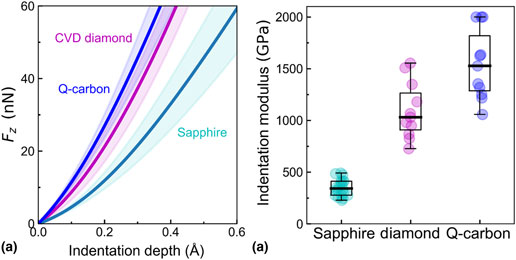Crossref Citations
This article has been cited by the following publications. This list is generated based on data provided by Crossref.
Narayan, Jagdish
Bhaumik, Anagh
Gupta, Siddharth
Haque, Ariful
and
Sachan, Ritesh
2018.
Progress in Q-carbon and related materials with extraordinary properties.
Materials Research Letters,
Vol. 6,
Issue. 7,
p.
353.
Haque, Ariful
and
Narayan, Jagdish
2018.
Stability of electron field emission in Q-carbon.
MRS Communications,
Vol. 8,
Issue. 3,
p.
1343.
Gupta, Siddharth
Sachan, Ritesh
Bhaumik, Anagh
and
Narayan, Jagdish
2018.
Enhanced mechanical properties of Q-carbon nanocomposites by nanosecond pulsed laser annealing.
Nanotechnology,
Vol. 29,
Issue. 45,
p.
45LT02.
Gupta, Siddharth
Sachan, Ritesh
Bhaumik, Anagh
Pant, Punam
and
Narayan, Jagdish
2018.
Undercooling driven growth of Q-carbon, diamond, and graphite.
MRS Communications,
Vol. 8,
Issue. 2,
p.
533.
Sachan, Ritesh
Hachtel, Jordan A.
Bhaumik, Anagh
Moatti, Adele
Prater, John
Idrobo, Juan Carlos
and
Narayan, Jagdish
2019.
Emergence of shallow energy levels in B-doped Q-carbon: A high-temperature superconductor.
Acta Materialia,
Vol. 174,
Issue. ,
p.
153.
Bhaumik, Anagh
and
Narayan, Jagdish
2019.
Formation and characterization of nano- and microstructures of twinned cubic boron nitride.
Physical Chemistry Chemical Physics,
Vol. 21,
Issue. 4,
p.
1700.
Gupta, Siddharth
and
Narayan, Jagdish
2019.
Non-equilibrium processing of ferromagnetic heavily reduced graphene oxide.
Carbon,
Vol. 153,
Issue. ,
p.
663.
Cellini, Filippo
Gao, Yang
and
Riedo, Elisa
2019.
Å-Indentation for non-destructive elastic moduli measurements of supported ultra-hard ultra-thin films and nanostructures.
Scientific Reports,
Vol. 9,
Issue. 1,
Bhaumik, Anagh
and
Narayan, Jagdish
2019.
Nano-to-micro diamond formation by nanosecond pulsed laser annealing.
Journal of Applied Physics,
Vol. 126,
Issue. 12,
Gupta, Siddharth
and
Narayan, Jagdish
2019.
Reduced Graphene Oxide/Amorphous Carbon P–N Junctions: Nanosecond Laser Patterning.
ACS Applied Materials & Interfaces,
Vol. 11,
Issue. 27,
p.
24318.
Narayan, J.
Gupta, S.
Sachan, R.J.
Niebroski, A.
and
Pant, P.
2019.
Formation of Q-carbon and diamond coatings on WC and steel substrates.
Diamond and Related Materials,
Vol. 98,
Issue. ,
p.
107515.
Gupta, Siddharth
Sachan, Ritesh
and
Narayan, Jagdish
2019.
Scale-up of Q‑carbon and nanodiamonds by pulsed laser annealing.
Diamond and Related Materials,
Vol. 99,
Issue. ,
p.
107531.
Sachan, Ritesh
Bhaumik, Anagh
Pant, Punam
Prater, John
and
Narayan, Jagdish
2019.
Diamond film growth by HFCVD on Q-carbon seeded substrate.
Carbon,
Vol. 141,
Issue. ,
p.
182.
Sachan, Ritesh
Gupta, Siddharth
and
Narayan, Jagdish
2020.
Nonequilibrium Structural Evolution of Q-Carbon and Interfaces.
ACS Applied Materials & Interfaces,
Vol. 12,
Issue. 1,
p.
1330.
Gupta, Siddharth
and
Narayan, Jagdish
2020.
Selective Liquid-Phase Regrowth of Reduced Graphene Oxide, Nanodiamond, and Nanoscale Q-Carbon by Pulsed Laser Annealing for Radiofrequency Devices.
ACS Applied Nano Materials,
Vol. 3,
Issue. 6,
p.
5178.
Bai, Haiqiang
Zhong, Lisheng
Shang, Zhao
Cui, Pengjie
Kang, Ling
Lv, ZhenLin
and
Xu, Yunhua
2020.
Microstructure and Fracture Toughness of Compact TiC-Fe Gradient Coating Fabricated on Cast Iron Substrate by Two-Step In Situ Reaction.
JOM,
Vol. 72,
Issue. 6,
p.
2154.
Haque, Ariful
Gupta, Siddharth
and
Narayan, Jagdish
2020.
Characteristics of Diamond Deposition on Al2O3, Diamond-like Carbon, and Q-Carbon.
ACS Applied Electronic Materials,
Vol. 2,
Issue. 5,
p.
1323.
Zare, Yasser
and
Rhee, Kyong Yop
2020.
Modeling the Effects of Filler Network and Interfacial Shear Strength on the Mechanical Properties of Carbon Nanotube-Reinforced Nanocomposites.
JOM,
Vol. 72,
Issue. 6,
p.
2184.
Joshi, Pratik
Gupta, Siddharth
Haque, Ariful
and
Narayan, Jagdish
2020.
Fabrication of ultrahard Q-carbon nanocoatings on AISI 304 and 316 stainless steels and subsequent formation of high-quality diamond films.
Diamond and Related Materials,
Vol. 104,
Issue. ,
p.
107742.
Nishikawa, Naofumi
2020.
Evidence of hydrogen termination at grain boundaries in ultrananocrystalline diamond/hydrogenated amorphous carbon composite thin films synthesized via coaxial arc plasma.
Journal of Vacuum Science & Technology B, Nanotechnology and Microelectronics: Materials, Processing, Measurement, and Phenomena,
Vol. 38,
Issue. 6,



